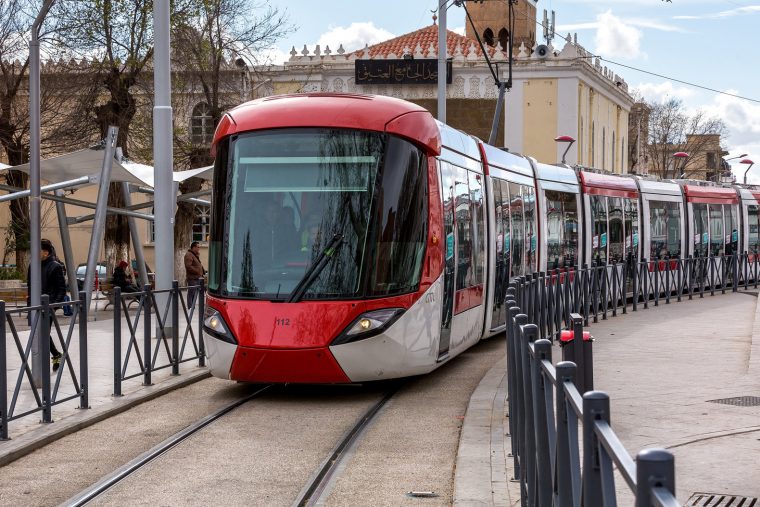Stratasys has become an increasingly important player in an increasingly important segment: 3D printed spares for transportation. As companies and municipalities turn to additive manufacturing (AM) to produce replacement parts for their trains, busses and trollies, Stratasys’ fused deposition modeling (FDM) has often become the tool of choice for durable components made quickly. The latest adopter is Alstom, a French multinational railway manufacturer who is 3D printing spares for Algeria’s Sétif Tramways.
When Sétif learned that the headlights of its trams were being damaged by the buildup of water and small stones entering small crevices, it turned to Alstom to provide spares to close the holes. The company has an internal 3D printing hub with which it 3D printed rubber drainage plugs.
“The agility that 3D printing gives us is critical for Alstom strategically as a business,” explains Aurélien Fussel, Additive Manufacturing Programme Manager at Alstom. “Where our customers depend on spare parts to maintain operations, having this in-house production capability means we can bypass our traditional supply chain and respond quickly and cost-effectively with a solution to their needs.”
 3D printed TPU plugs. Image courtesy of Stratasys.
3D printed TPU plugs. Image courtesy of Stratasys.Using its based Stratasys F370 3D Printer, the company was able to 3D print the items in just 48 hours, truncating what would have been an otherwise 45-day lead time. The partners also estimated that 3D printing the parts “led to additional savings for Sétif in the form of an 80% reduction in fixed cost. Together, the project saved Sétif approximately 6,000 euros’ fixed cost.”
“We avoided the minimum three-week production lead-time typically required of traditional manufacturing methods and ensured the tram network’s operations were minimized,” Fussel said. “For our transportation customers like Sétif, every minute of lead time within a network means lost revenue, so every minute we can win back when solving maintenance issues reduces that loss.”
Alstom highlighted the materials offered by Stratasys as being crucial to the project. The firm used FDM TPU 92A, a durable elastomer, which was able to provide the necessary flexibility and elasticity, while also offering abrasion and tear resistance. As a result, the rubber drainage plugs are still in operation, according to the company.
 A Sétif Tramways tram. Image courtesy of Stratasys.
A Sétif Tramways tram. Image courtesy of Stratasys.With a 2018 revenue of €8.1 billion, Alstom is a major player in the rail industry. Previously, the multinational was also much more important in the energy sector but sold its assets to GE Wind to form a joint company. Meanwhile, the company has continued to grow rail as its now primary business. While it failed to complete a merger with Siemens Mobility, purportedly to take on Chinese rail, it is in the process of finalizing trains for Amtrak’s Northeast Corridor. This is the only high-speed rail (HSR) in the U.S., though it does not reach the same average velocities as those in other countries.
In addition to producing HSR, such as the TGV high-speed trains in France, it has also manufactured trainsets for the London subways system and trams for some 28 cities around the world. In January 2021, it acquired Canada’s Bombardier Transportation, making it one of largest companies in rail vehicle and equipment manufacturing and servicing. Its work in Algeria saw the multinational deliver 26 Citadis trams to establish the first public tramway in the city of Sétif.
By expanding its reach in the rail and replacement part sectors, Stratasys is further cementing its position in a growing sector. Likely helped in part by the company’s membership in the Mobility Goes Additive consortium, the company is being deployed by various transportation outfits to produce on-demand spare parts. Siemens Mobility, for instance, is using FDM for train maintenance in locations like Germany, the U.K., and Russia. In Italy, Neapolitan public transport company Azienda Napoletana Mobilità relied on Stratasys to repair its trolleybuses.
So, while aerospace and automotive may generate the highest number of web clicks, 3D printing in public transportation and rail is rapidly growing. Many of the current projects involve the use of additive manufacturing for replacement components, but, as Wabtec is demonstrating, it will increasingly be used in the production of end parts. And, as rail will be increasingly relied on in a United States shifting to electric transportation, now is a good time to introduce 3D printing to the industry.
Subscribe to Our Email Newsletter
Stay up-to-date on all the latest news from the 3D printing industry and receive information and offers from third party vendors.
You May Also Like
Further Understanding of 3D Printing Design at ADDITIV Design World
ADDITIV is back once again! This time, the virtual platform for additive manufacturing will be holding the first-ever edition of ADDITIV Design World on May 23rd from 9:00 AM –...
3D Printer Maker EVO-tech Reborn as NEVO3D — Once More With Feeling
EVO-tech was a 3D printing service and original equipment manufacturer established in 2013 and based in Schörfling am Attersee, Austria. The company produced high-quality material extrusion systems featuring linear bearings,...
3D Systems Brings 3D Printed PEEK Cranial Implant to the U.S. with FDA Clearance
For more than 10 years, 3D Systems (NYSE:DDD) has worked hand-in-hand with surgeons to plan over 150,000 patient-specific cases, and develop more than two million instruments and implants from its...
CDFAM Returns to Berlin for Second Annual Symposium
The second CDFAM Computational Design Symposium is scheduled for May 7-8, 2024, in Berlin, and will convene leading experts in computational design across all scales. Building upon the first event...































